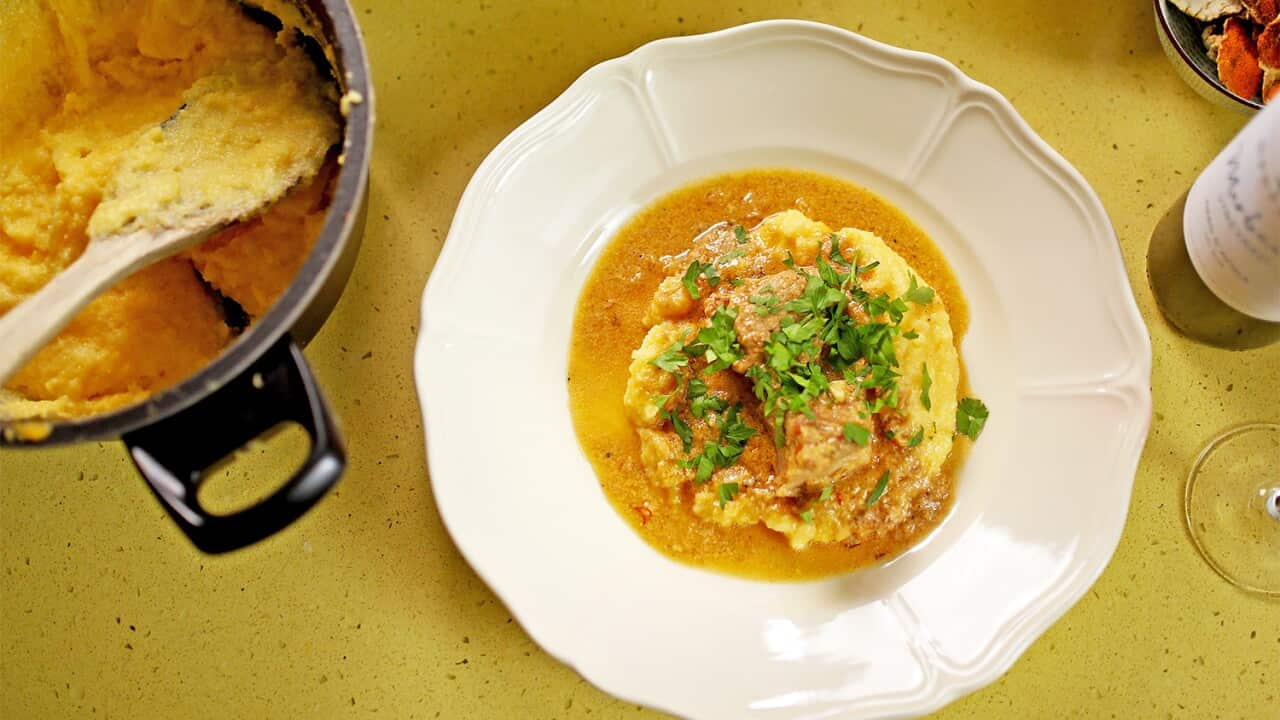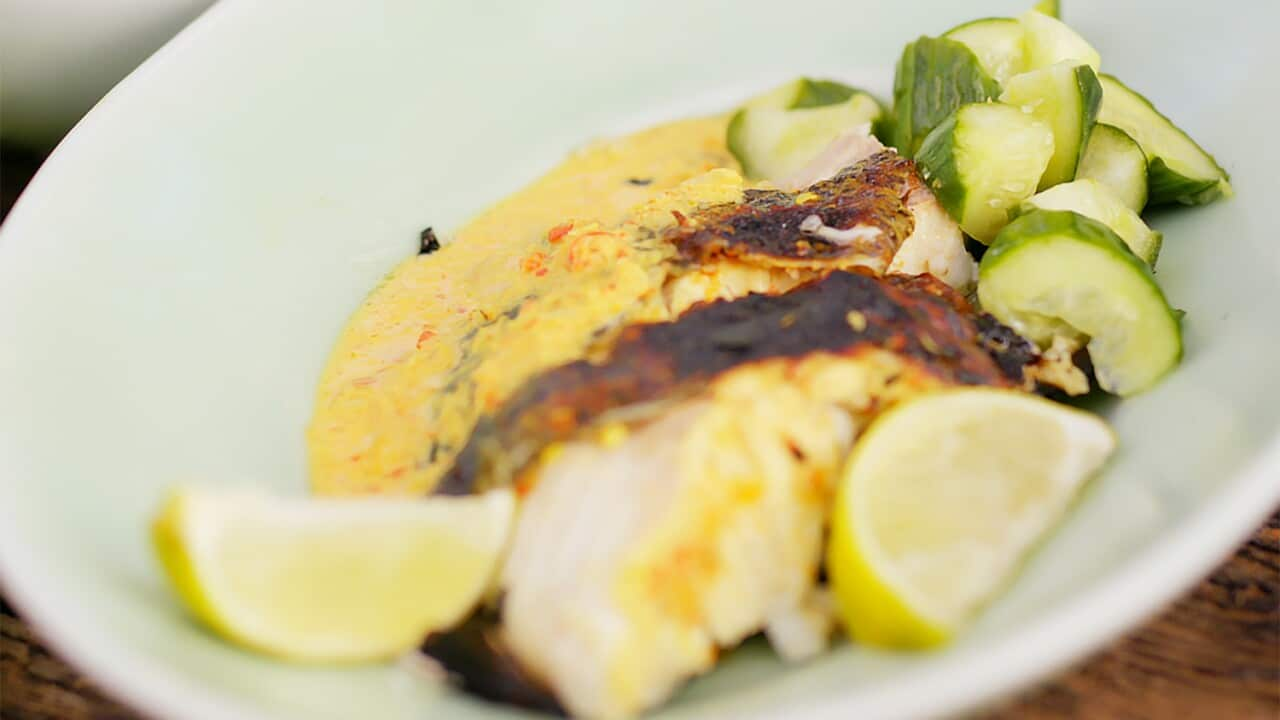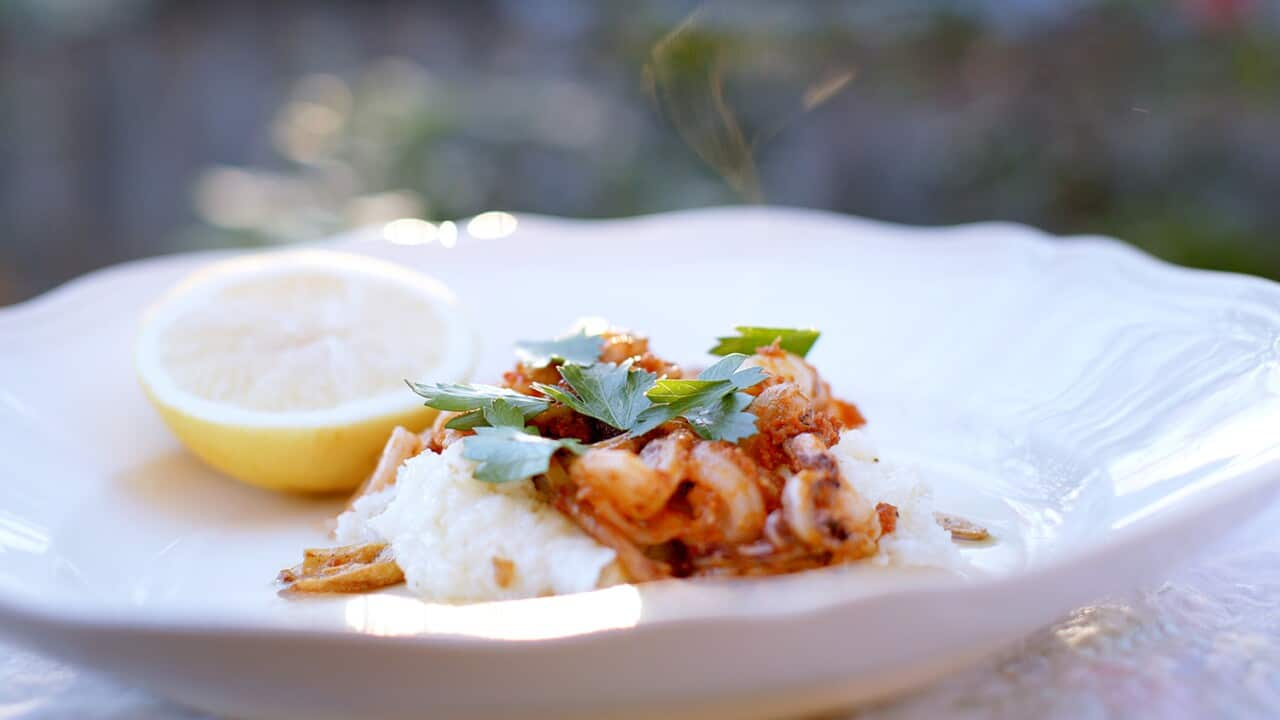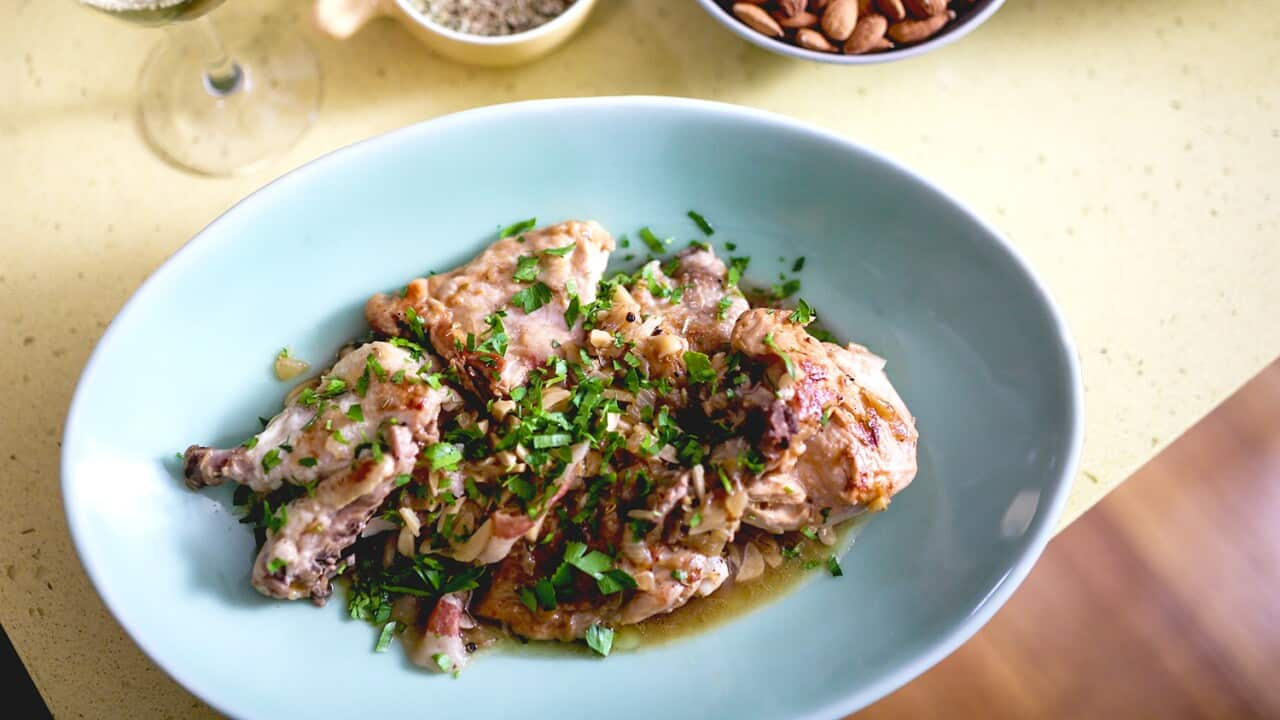Chef and TV host Stefano de Pieri explores the important issues of food sustainability and water management while admiring the stunning, natural beauty and rich fruits of the Murray-Darling river system. Throughout the series, he cooks up some incredible, simple dishes with produce straight from the source.
Episode 1 | Innovations in farming
The land of Australia’s Food Bowl is dry and desert-like, yet it is plentiful with produce and home to some of Australia's biggest fruit and veggie growers - thanks to the water from the Murray. Many factors affect the limited water supply to local farmers and recently, times have been tough. Stefano visits a couple of local producers who are developing ways to overcome these challenges and coming up with innovative ways to combat the obstacles they face.
In the north-western corner of Victoria, in the Mallee region, Stefano visits potato farmer Peter Corcoran. Peter’s family has been growing potatoes for sixty years, and with the land and water prices continually on the rise, Peter is working hard towards a zero-waste operation that he shows to Stefano. Gifted with some of Peter’s Neptune spuds, Stefano is inspired to cook a mild potato and snapper curry.
Brothers Paul and Craig Crouch have been innovative in their techniques to increase their farm’s yield and save water. Originally dried fruit growers, they started farming snow peas ten years ago and more recently sugar snap peas as well. They’re now saving fifty per cent on water using their clever and innovative techniques, and the result is incredibly fresh and crisp snow peas that Stefano uses to cook baccala (salted cod) with mixed peas.
Episode 2 | Olive oil
The Mediterranean-like climate of Australia’s Food Bowl makes it the perfect place to grow olives and to produce olive oil. Stefano visits Australia’s most successful olive oil producer to share why this golden liquid is the best and purest of all.
At home, Stefano prepares a simple pangrattato - also known as “poor man’s parmesan” - which consists of fried breadcrumbs with garlic and herbs. He then travels to Boundary Bend Estate to meet with an old friend and Australia’s largest olive oil producer, Rob McGavin.
It’s harvest time and the olives here are picked, juiced and bottled within just four hours. It’s this fast process that results in the purest of all oils, extra virgin olive oil. This rich golden liquid is full of healthy fats and high in natural antioxidants and flavour. It’s an essential item in almost every kitchen, from home cooks to the best chefs. It is also the hero ingredient of the classic Italian spaghetti aglio e olio which Stefano prepares al fresco in the olive groves.
Olives use less water than many other crops and Rob is just as passionate about water-saving methods and sustainability, as he is about producing the freshest extra virgin olive oil possible. Together, Rob and Stefano discuss water issues and future solutions for farmers.
RECIPES

Spaghetti aglio e olio
Episode 3 | Festa - celebrating grape harvest
In March at the beginning of Autumn, growers, farmers and the local food community gather in Mildura to celebrate the annual grape harvest with a Slow Food feast under the vines. The Festa della Vendemmia has been running for twenty years, and this year, Stefano returns to the role of executive chef for this special event. Stefano wants to create a delicious degustation with ingredients that he sources from the region’s finest food producers. He devises a delicious Italian menu that really makes the local ingredients shine on the plate. He starts with bread, hand-made by his friend and host of the event Elina Garreffa. This bread is for his pappa al pomodoro - a simple soup made with bread and tomatoes.
For the tomatoes, Stefano visits local agronomist Brenton Frahm who not only grows tomatoes but also has fields bursting with fruits and vegetables. In fact, his rockmelons look perfect for another dish Stefano has in mind, grilled rockmelon with goat feta, made with cheese sourced from nearby Coomealla Dairy. Also on the menu is poor man’s ham with pickled grapes - with a lamb ham prepared especially for him by veteran butcher Naz Tessone. For dessert, Stefano picks mangoes, grown on a friend’s property in nearby Irymple.
With 200 hungry guests to cater for, Stefano enlists two respected chef friends to help him with the celebration feast. Together with many volunteers, they tackle the task of preparing and cooking eight different dishes served as four courses on the night. On Saturday night, under the vines at Tabletop Grapes, guests mingle, dance, and feast on this thoughtful menu. Devised with only local ingredients and traditional cooking, it is a true celebration of the slow food movement and the year’s plentiful grape harvest.

Source: Australia's Food Bowl
Australia’s Food Bowl is home to some of the biggest food producers in Australia. It is the second-largest citrus-growing district in the country, and produces more than 70% of Australia’s vine fruits. The region is best known for traditional crops such as citrus and grapes, however they are thirsty plants and rely heavily on the river system for irrigation. In recent years, many farmers have started to diversify and are finding success growing unique and lesser-known, exotic fruits.
Stefano looks at the new wave of fruits being grown in Australia’s Food Bowl, first he visits farmer La Tuyen, who has a small plot growing an ancient fruit called a Jujubes. These bright red fruits are also known as Chinese dates and can be eaten fresh or dried. Stefano’s next stop is in Nangiloc to a persimmon orchard. Phil Baker’s family has grown fruits and vegetables for generations. Their persimmons are mostly sold to overseas markets but Australians are slowly becoming more adventurous about what they have in their own food bowls at home.
One fruit that has seen a surge in popularity is the pomegranate. Regarded by many as a 'superfood', it grows well under the Mildura sun, especially at Denise and Neville Crisp’s farm on the banks of the Murray River. The fruits inspire Stefano to create a fresh pomegranate and radicchio salad with tahini dressing.
Dates have also become a popular fruit in Australian households, with their sweet flavour used in many desserts. Former fisherman Peter Middleton decided it was an ideal crop to grow in Mildura, with its hot dry climate that resembles the desert. Stefano uses these dates to create an Italian savoury dish called maiale al latte (Pork in milk with dates).
Episode 5 | Murray cod
The Murray Cod is Australia’s largest freshwater fish and native to the rivers of Australia’s Food Bowl. It is also steeped in the rich Indigenous history of the region. Ancient stories tell of a giant ponde (cod) that created the Murray River. Barkindji elder, Peter Peterson shares this creation story with Stefano and tells of growing up on the river in the days when the Murray cod population was plentiful.
Iain Ellis is a fisheries expert who explains the changing face of Australia’s longest waterway and the water crisis jeopardising the native fish. Stefano visits a fish farm growing sustainable Murray cod, run by father and son duo Gleneck and Jaeben Underhill. It is here that Stef sources some fish for cooking. He calls on two former cooks and now friends of his, local Barkindji woman Tamara Peterson, Peter’s daughter, and her cousin Whittney Kirby, to share with him a delicious smoked cod recipe by the banks of the river.
Renowned chef Tony Tan pays Stefano a visit and prepares a Murray cod with Asian flavours in a stunning riverside location. Ginger, galangal and coconut with banana leaf are delicious additions to enjoy this native fish by the river.
Episode 6 | Healthy vegetables
The rich red soil of Mildura, coupled with precious water from the mighty Murray River, provide the perfect conditions to grow vegetables, and lots of them! A healthy river results in healthy vegetables and Stefano loves to cook with the freshest local vegetables around.
Italian cooking is about eating what's in season and simple creations using the freshest ingredients. Autumn is a wonderful time for vegetable farmers and Stefano visits the Minter Family who have been growing asparagus in the region for five generations and almost a hundred years. Father and son team Darren and Gary Minter manage their 650 acres of mixed horticultural plantings. The main permanent crops are almonds, citrus and asparagus.
Stefano uses some of the Minters’ produce to create a mouth-watering grilled asparagus with Taleggio dish. Stefano drops in to see his friend, local grower and agronomist Brenton Frahm and find out what he is harvesting. He collects bullhorn capsicums from Brenton, and also gets a tip about a family down the road with an abundance of eggplants. This inspires Stefano to create a hearty lunch for the local veggie farmers with the produce they grew themselves. He combines the two to create delicious stuffed bullhorn capsicums, that are sandwiched between fresh and crusty Italian bread.

Source: Australia's Food Bowl
Garlic is an essential kitchen ingredient across cuisines in every culture around the world, and Stefano explains why Australian-grown garlic is far superior in taste and much healthier than imported garlic.
Stefano’s friend Nick Diamontopolous is a garlic guru who has dedicated the last twenty years to growing garlic and has hundreds of varieties of garlic planted in the rich soils of Australia’s Food Bowl. For a long time, Australia has imported a lot of its garlic from overseas, but Nick is on a mission to convince Australians to buy Australian-grown garlic rather than from overseas.
Together, Stefano and Nick plant bulbs in Stefano’s home garden so he may one day have his home-grown garlic. They’ll visit the Australian Garlic Producers in Robinvale to see the soils where Nick’s garlic is flourishing and they’ll take a look at the sheds where the garlic is cured and sorted, all by hand.
Stefano tastes some different garlic varieties and finds out more about the health benefits of garlic, and new developments in products such as vitamin-rich garlic oil pills. He celebrates garlic with a delicious barbecued calamari and with garlic dish and a simple yet tasty chicory salad with garlic and anchovies.
Episode 8 | Almond and Bees
Bees play an important role in horticulture, over fifty percent of what we eat relies on bees for pollination. In Australia, the almond industry relies heavily on bees for pollination and Stefano takes a closer look at their relationship as well as the water consumed to produce this popular superfood.
Stefano travels to Hattah-Kulkyne National Park in the Mallee district to see local beekeeper Roger Moser who has thousands of bees in hives. He has been bringing his bees here for forty years to rest, as they prepare for their job ahead of the almond pollination duties. Stefano will catch up with Roger again when he transports the bees to the almond orchards, but first he takes some fresh honey to create a sweet honey ricotta and citrus dish.
Stef also talks to former waterways manager and tour guide Peter Kelly who shows Stefano through the pristine habitat and sees a thriving natural landscape as a result of the environmental water management.
As the winter season ends, Roger’s bees travel to Minter Magic farm near Mildura, to work their magic and pollinate the almond trees. Stefano walks amongst the stunning orchards filled with almond blossoms and is inspired to make a Tuscan-style pollo al finocchietto (chicken with fennel) to which he adds slithered almonds.
Episode 9 | The Darling Barka
The river system is the lifeblood of Australia’s Food Bowl. Its water supply is crucial to the lives and communities of this region. The Darling River - known as the Barka in Barkindji language - is part of one of the largest river systems in the world.
Barkindji man and respected Elder, Uncle Peter Peterson meets Stefano and tells him about life growing up on the Barka and its significance to the lives of the Indigenous communities.
Stefano is also joined by local indigenous women and former apprentices of his, Whitney Kirby and Tamara Peterson, who prepare a dish of kangaroo rissoles which they cook up by the river while they share some yarns with Stef about their life growing up on Barkindji land.
The river is also an essential part of life for farmers. Stefano visits Rachel Strachan, a sheep farmer and former citrus grower who has seen the water levels drop down to nothing at her property on the banks of the Darling River.
Water authorities have recently released water from Menindee Lakes and now, for the first time in three years, Rachel and her family see water run down the River arriving at their property. Stefano cooks up a celebration meal of mutton, prepared consciously considering the hard times the River folk have endured.

Source: Australia's Food Bowl
Many farming families have a long history of growing produce and we meet some of the inspiring people who have been working the land for generations. Fathers and sons, husbands and wives, brothers and sisters. It is their connection to the land, river, and to each other that makes Mildura such a special place. Stefano looks at the community and meets some of the characters of Australia’s Food Bowl.
Stefano visits the Gallace family in Robinvale, who run several innovative farms producing grapes, dried fruits and olives. At Sapphire Grapes, Adam Gallace has developed some fascinating technological innovations that he shows Stefano. Across the road at Robinvale Estate, Stefano walks through the olive orchards with Adam’s sister, Kim Natale who now runs the family boutique olive oil business created by her father. The sight of freshly pressed extra virgin olive oil inspires Stefano to use it in a dessert recipe for halva with pistachios.
In Mildura, Stefano visits Fossey’s Gin Distillery and meets master gin-maker Steve “Fossey” Timmis, who creates gin that highlights Mildura’s produce and history. With the abundance of produce in Australia’s Food Bowl, Fossey’s gin creations truly celebrate the flavours of the region.
On the rolling plains of Nangiloc, outside of Mildura, husband and wife team, Glen and Kristi Goldup grow popular produce such as the almighty avocado as well as traditional fruits with their boutique breed of citrus. Glen is a third-generation farmer and his parents still live on the farm. Inspired by the producers he meets, Stefano creates a modern gin-cured salmon, avocado and citrus bruschetta using Fosseys gin and avocado and citrus from the Goldups.





















